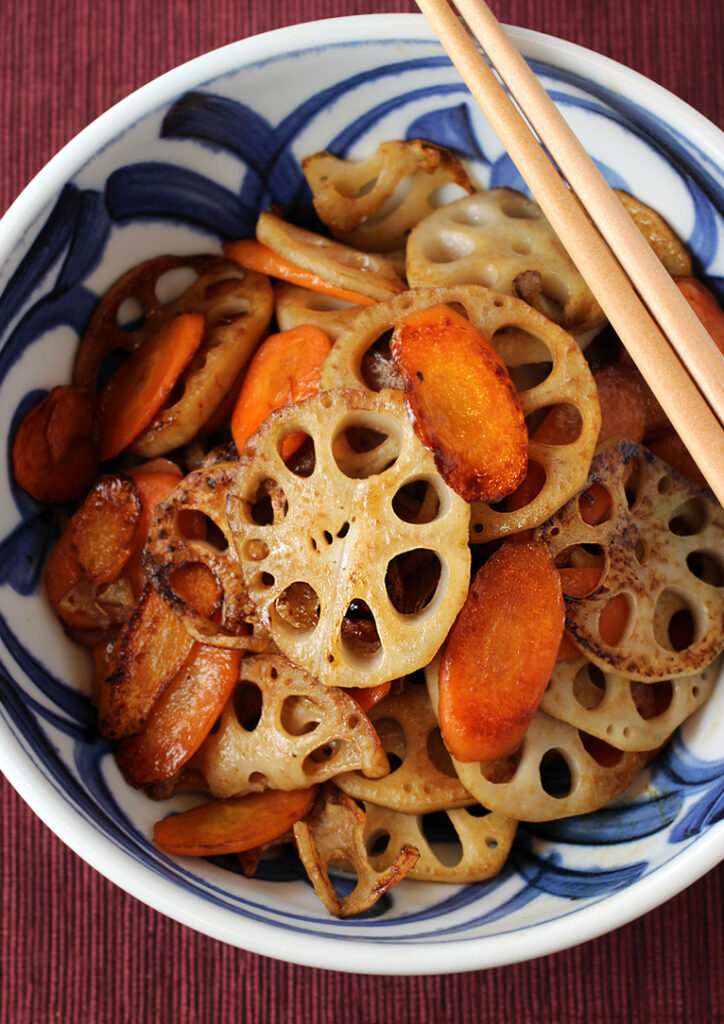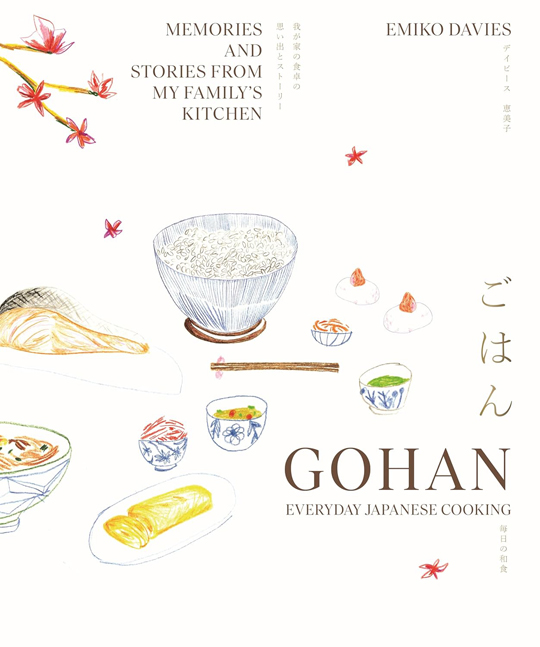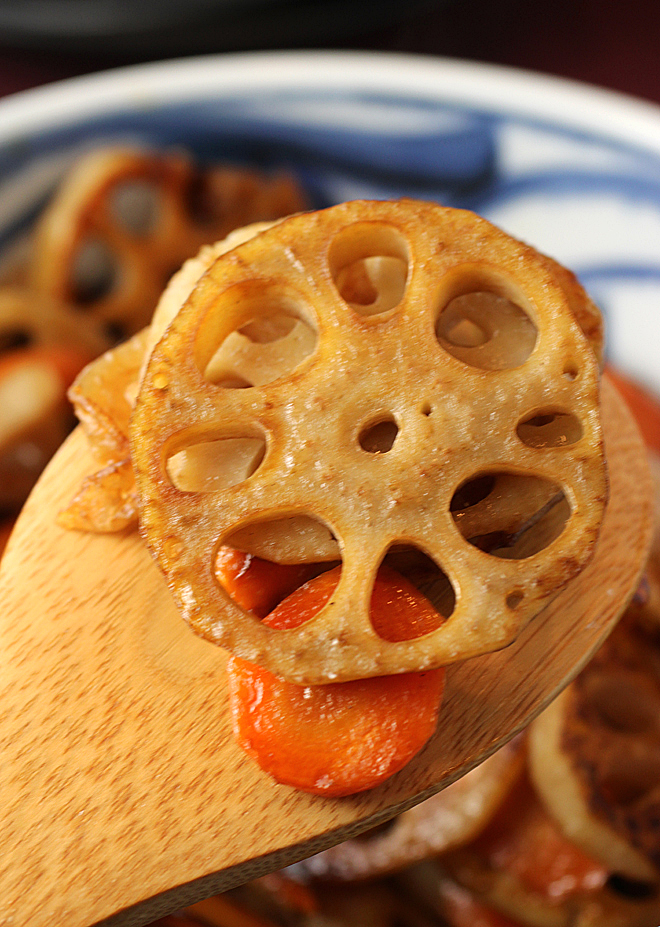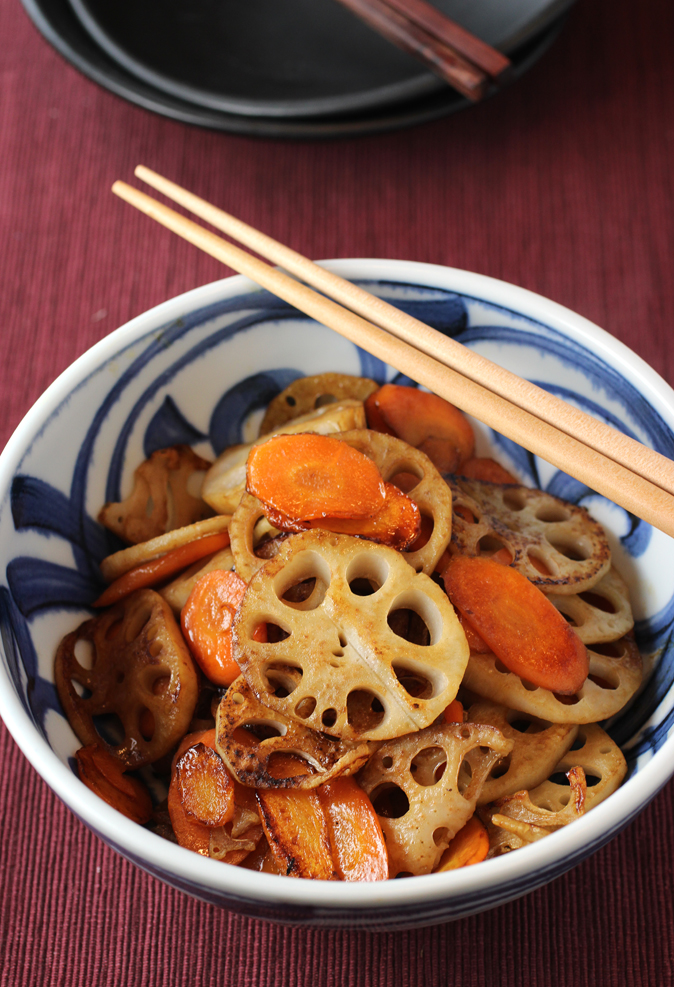Welcoming 2024 with Fried and Braised Lotus Root and Carrot

After indulgent holiday prime rib, potatoes au gratin, and countless buttery pies, rich puddings, and lofty cakes, time to start the new year off on a lighter note, don’t you think?
If so, then “Fried and Braised Lotus Root and Carrot” fits the bill.
It is the simplest of Japanese side dishes with a whole lot of crunch and sweet caramelization.
It’s from the cookbook, “Gohan: Everyday Japanese Cooking” (Smith Street Books, 2022), of which I received a review copy.

The books is by Emiko Davies, an Australian-Japanese food writer and photographer who now lives in Italy. This is her sixth cookbook, and the first one centered on Japanese cuisine.
This is not the Japanese fare of Tokyo kaiseki restaurants or trendy, hidden izakayas. Rather, it is the food from kitchens of Japanese mothers and grandmothers, including her own.
In fact, “gohan” means “rice” in Japanese. As such, these are homey recipes very much designed to be enjoyed with a steaming bowl of pearly, fragrant grains. That means everything from “Braised Eggplant” and “Salted Grilled Chicken Skewers” to “Curry Croquettes” and “Fried Pork Cutlet with Miso Sauce.”
Winter is when fresh lotus root is harvested. But you can also find it year-round in the freezer case of Asian markets. Slices will jazz up any dish, what with their distinctive hole-patterned interior that gives the look of lacy medallions.

Davies finds the frozen slices thicker than she would like, so she suggests carefully cutting them thinner. I found it was easiest to do that when the slices were still semi-frozen. That provided enough give to allow the knife edge to penetrate a slice yet still enough sturdiness to make slicing less of a potential hazard. Truth be told, you could also just leave the slices as thick as they come and the dish will taste fine.
Then, it’s just a matter of adding the lotus root slices, along with carrot slices, to a skillet with sesame oil over medium-high heat to get a good sear on both sides. After that, pour in a mix of sake, mirin, and sugar, and continue cooking until the liquid is nearly evaporated. If you don’t have sake on hand, just add a little more mirin instead. Finally, drizzle in a little soy sauce, and just like that, it’s all done.
The lotus root has a wonderful nutty taste with a subtle natural starchy sweetness. It retains its crispiness even after cooking, reminding me a lot of water chestnuts. The carrots echo that sweetness and crunch.
Davies writes that her mother likes to add fresh slices of hot red chilli to the dish. I can see how that would be delicious. I like piling it atop a big bowl of fluffy steamed rice, and letting its comforting simplicity reset and recharge instantly.

Fried and Braised Lotus Root and Carrot
(Serves 4 as a side dish)
300 grams (10 1/2 ounces) lotus root, thinly sliced (see Note)
1 tablespoon sake
1 tablespoon mirin
1 teaspoon sugar
1 tablespoon sesame oil
1 large carrot, peeled and thinly sliced on the diagonal
1 tablespoon soy sauce
Soak the slices of lotus root in some cold water for 5 minutes to avoid discoloration (some like to add a splash of rice vinegar to this mixture), then pat dry.
Meanwhile, combine the sake, mirin, and sugar and stir to dissolve the sugar.
Heat a frying pan (skillet) over medium-high heat, and add the sesame oil and begin frying the lotus root and carrot slices, tossing frequently with a spatula (or chopsticks) to ensure even cooking. After about 5 minutes, when the vegetables are halfway cooked, add the sake mixture and continue cooking until the liquid is almost entirely evaporated and the vegetables are just about done, at most a further 5 minutes. The lotus root should still have some crunch to it, the carrots should be sweet and a little soft and both should have some lovely browning (but not too much so be careful, as the sugars in both lotus root and carrot tend to make them brown very easily). Add the soy sauce, toss quickly to coat the vegetables and remove from the heat.
Serve hot, tepid, or even cold the next day.
Note: If you find it difficult to find fresh lotus root, you can look for pre-cut, frozen lotus root at Asian grocers. I find these are often too thick for this dish. Although it’s a bit fiddly, you can defrost the thick slices and then carefully slice them as thinly as you can to use here.
From “Gohan: Everyday Japanese Cooking” by Emiko Davies
